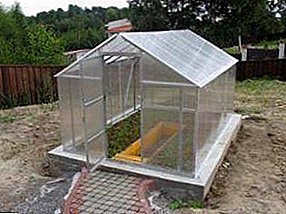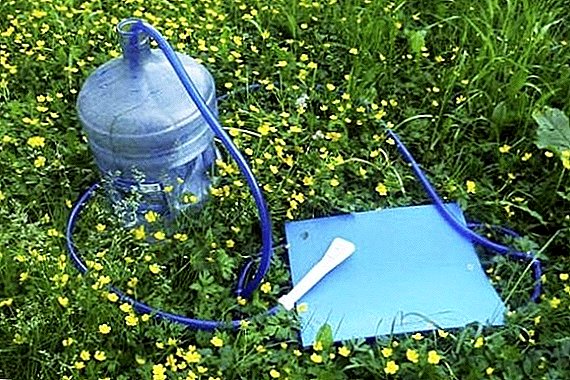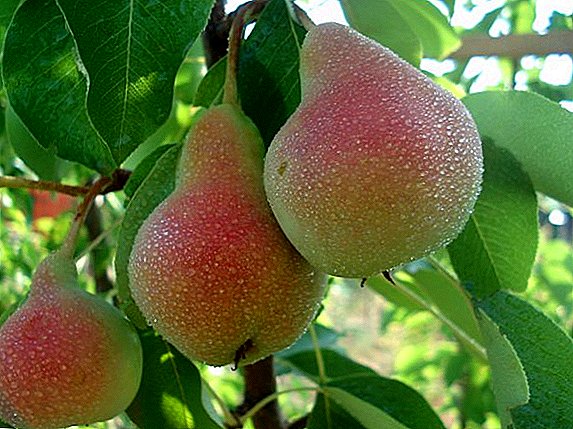
Increasingly popular among gardeners and avid gardeners are polycarbonate greenhouses becoming the foundation for greenhouses of this type can be made independently, and the choice of material and method is quite wide.
In this article we will take a closer look at whether a foundation for a greenhouse made of polycarbonate is needed, from which it is best to make it, considering the functions of the greenhouse.
Foundation Functions
Some inexperienced gardeners believe that the country greenhouse can be installed using the pins included in the kit, or simply put on the ground. However, this is not entirely true.
Such a decision often leads to unpleasant consequences. The greenhouse can carry any gust of wind, and it will begin to randomly move around the site.
But even if the structure remains in place, it can twist due to the softness of the soil.
Under the base cracks are formed, which will let in cold and various living creatures creeping and running around the site, which means that the plants in the greenhouse will suffer.
In this way, foundation performs the following functions:
- Fixes the frame of the greenhouse.
- Protects internal space from cold and uninvited guests.
- Isolates walls from contact with the soil.
The choice of the foundation, and this is the basis for a polycarbonate greenhouse, depends primarily on how stationary you plan to make the structure. If the greenhouse is planned to be moved around the site every season, the foundation should also be easier and more mobile. In some cases, there may be a greenhouse without a foundation.
For the greenhouse, which will be operated in one place all the time, it is more expedient to make a more durable base.
And now we will consider how to make a foundation for a greenhouse with your own hands from polycarbonate, how to choose a suitable material, which one is better.
Types of foundations depending on the material
Wooden
 The cheapest and easiest option. For manufacturing need a wooden beam.
The cheapest and easiest option. For manufacturing need a wooden beam.
This view is recommended to install under the mobile structure, as it is easy to dismantle and move to a new place.
The minus option is its fragility, as the tree can quickly rot under the influence of moisture.
For the manufacture of the foundation, a wooden bar with a cross section of 10 cm is purchased. After marking the site, a trench is dug out with a cord. The timber is laid in the soil at half the height.
To protect against moisture, wood is wrapped with roofing felt or other insulating material. You can also coat it with special protective mastic. For greater stability, the bottom of the trench can be filled with fine gravel.
It will also help with additional waterproofing material. After laying the bars are interconnected by braces.
Blocky
Recommended for use in places that have excessive moisture. Alternatively, used concrete curbs can be used.
To produce it, they dig a trench about 25 cm wide by the applied marking. The depth is determined by the level of soil freezing characteristic of a certain area. The bottom of the trench by 10 centimeters is covered with gravel or rubble. Cement mortar is poured onto the gravel from above.
A layer of blocks is laid around the entire perimeter, starting from the corners. A solution is poured into the voids, and the voids along the edges are filled with soil. The top of the blocks is leveled with cement mixture.
This view should be flush with the soil. A layer of red brick is laid on it, about five rows in height, holding everything together with cement mixture. The seams between the bricks are carefully sealed.
Brick-concrete
The trench in this case is digging at a lesser depth, about 10-15 centimeters. But if you plan to grow seedlings in a greenhouse, such a foundation will not work. Frost may well get inside the structure and destroy the plants. Brick foundation suitable for greenhouses in which plants are grown in spring and autumn season.
The trench width for a brick foundation should be 20-25 cm. The earth, for protection against destruction, is reinforced with formwork from planks. The concrete form is poured into the formwork flush with the soil. Concrete is leveled to the level and anchor bolts are inserted into it for future fixing of the greenhouse frame.
A week after pouring, when the concrete hardens, a row of red bricks are laid on the concrete. Laying should be done in such a way that there are no empty spaces between the rows, and the bolts are located in the joints between the bricks.
Spot on support pillars
 This is a special kind of base for small greenhouses. exclusively spring-summer use. At the same time, it is the easiest and fastest to build, as well as the cheapest option.
This is a special kind of base for small greenhouses. exclusively spring-summer use. At the same time, it is the easiest and fastest to build, as well as the cheapest option.
For installation, supporting posts made of timber, concrete blocks or regular hemp are used. Their height is 50 cm, the number is determined by the size of the greenhouse. The pitch between the bars should be a meter.
By marking in accordance with the size of the greenhouse establish columns, starting with the corners. Sealing is made flush with the soil. The construction corner for fixing the greenhouse frame is laid on the dug-in posts.
Concrete
This kind of greenhouse base is alternative to block. For its production is used ready-made or self-prepared concrete mix consisting of cement, sand and rubble (1: 3: 5).
The pouring begins with the preparation of wooden formwork. Shields are installed around the perimeter of the markup in a dug trench. The bottom of the trench is covered with a layer of sand, formwork is installed on it. 40 cm high. Boards are sunk to a height of 20 cm.
In the finished formwork evenly around the perimeter, the concrete mix is poured in layers. Each layer is carefully tamped. For strength, metal reinforcement is laid in concrete. The above-ground part can be finished with a layer of bricks in several rows.
After complete hardening, after about 7-10 days the formwork is removed. This basis is most durable and durable. In addition, it is the most reliable protection of the internal space of the greenhouse from rodents and cold. Capital greenhouse on the foundation is usually arranged on this material.
A photo
See below: the foundation for polycarbonate greenhouses a photo





Stone
The stone at all times was most reliable material for construction. For its manufacture, it is necessary to have certain masonry skills, therefore it is better to entrust its manufacture to an experienced bricklayer.
The material for the manufacture can be any stone, mined in your area. For masonry, choose a stone that meets the following parameters:
- Size up to 50 cm;
- No cracks and other defects;
- Configuration for ease of installation.
Stones are laid on a low sand cushion. The first row is put dry, the largest, flat stones.
The remaining stones are moistened and cleaned from staining before laying. The stitches during laying should not exceed 1.5 cm. It is also necessary to avoid contact of stones without a solution between them.
If the structure of stones does not allow laying them close, then the voids are filled with rubble. The tamper during installation is produced with a hammer, in order to avoid the subsequent destruction of the structure.
Monolithic concrete slab
Is an the most reliable and durable. Such a view is simply necessary in areas with unstable ground.
To fill the slab, first prepare a mound of gravel or dig a pit with a cushion of gravel. Further technology coincides with the pouring of the concrete strip foundation, only the formwork is created in the form of a box equal to the area of the greenhouse. Concrete is poured into this box in layers.
The manufacturing techniques of the monolithic concrete base have the technical features, therefore it is better to entrust its construction to experts.
On screw piles
Screw piles are steel pipes with a height of 1.2 meters, equipped with curved blades for immersing them in the ground. Depthing is done using special mechanisms or manually.
 Preliminary drilling of wells is not required, since the structure of the piles presupposes their independent screwing into the ground.
Preliminary drilling of wells is not required, since the structure of the piles presupposes their independent screwing into the ground.
The installation process of the greenhouse on such a basis is carried out within a few hours.
Pile foundation is particularly durable and able to withstand the load from five to two hundred tons. At the same time screw piles can be installed in any soil.
Especially recommended is the installation of such a foundation on silty and low web sites, as well as with close location of groundwater.
The advantage of the installation is the absence of the need for preparatory work on the ground. Preparation consists in alignment of a site on which piles are then mounted. For mounting the base of the greenhouse at the piles manufacturers have special tips.
Installation of polycarbonate greenhouses on the foundation - important stagerequiring compliance with all rules. Only in this case, you can be confident in the strength of the structure and ease of its operation in the garden season.












